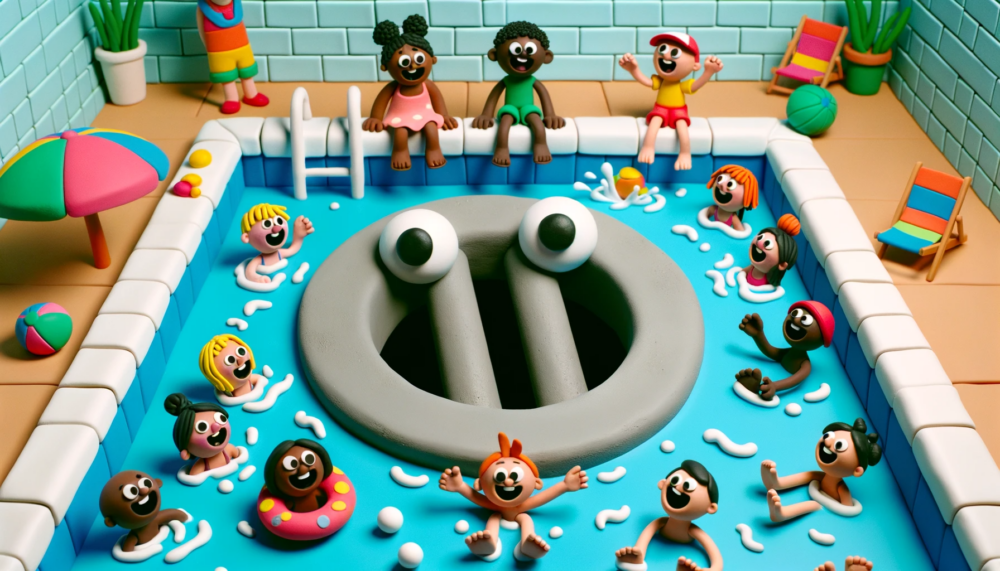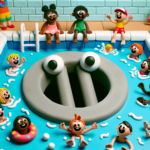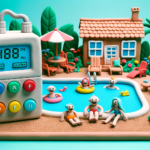The main drain is an important component of a swimming pool’s circulation system. In-ground swimming pools typically contain one or more drains. Above-ground pools rarely come equipped with a main drain, but some pool owners choose to add them.
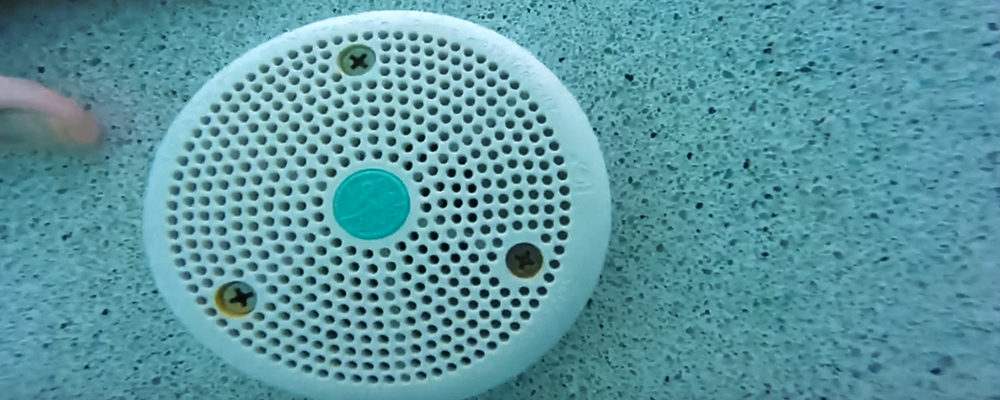
Using a strong force of suction via the pool’s pump, the main drain draws water, collecting large and heavy debris in the process. After the water flows through the drain, it makes its way to the pool’s filter. Due to the main drain’s strong force of suction, it must be topped with a grated cover.
However, not all drain configurations and covers are equal in terms of safety. Dual-drain setups are safer than a single main drain, and curved covers are more likely to prevent injuries to swimmers than flat ones. There are also secondary protective mechanisms you can use in conjunction with the main drain.
We have not only reviewed some durable and legally compliant drain covers but also worked up a guide for buying pool drains. In our guide, you’ll learn about applicable drain cover laws, what marking should be on a cover, how to safeguard swimmers around drain covers, and much more.
This website is supported by readers. As an Amazon Associate we earn from qualifying purchases.
Best Pool Drains
Best Pool Drain Buying Guide
If your swimming pool has one or more drains, proper covers are a safety-must. While main drains in residential pools aren’t subject to the same federal laws that pertain to public swimming pools, following those guidelines will help keep swimmers safe in your pool.
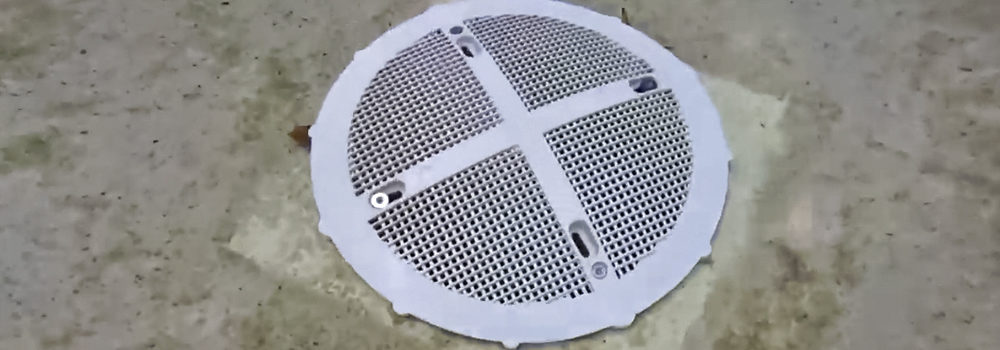
Safe drain covers are shaped in a way that prevents them from becoming completely blocked. They will also have markings that detail their expiration date, mounting location, and flow rate. When it isn’t possible to have two main drains, there are other mechanisms you can add to your swimming pool.
This buyer’s guide tells you how to determine whether a drain cover is safe and what to do with the main drains when you winterize your pool. It also explains the benefits of a dual-drain system. If you use an automatic pool cleaner, there’s some information about drain clips in the guide that will interest you.
The Virginia-Graeme Baker Pool and Spa Safety Act
In 2002, a child named Virginia became trapped underwater in a spa due to the amount of force behind the drain’s suction. To protect swimmers of all ages, the United States passed the VGB Act in 2007, which extends to public pools and spas.
In the scope of pool drains, the VCB Act requires public pools to use drain covers and systems that reduce the likelihood of entrapment. While residential swimming pool owners aren’t legally obligated to follow the rules in the VGB Act, some states, counties and cities have adopted the language of this law into their legal codes for residential pools.
Unsafe Drain Covers
Drain covers made before the VGB Act are much different than those made in 2008 and later. Pre-VGB drain covers were grated just like the safer ones on the market today, but these old-style covers were flat. This design increases the drain’s suction power and makes it difficult for a swimmer to release themselves from the pull of the drain.

Entrapment Dangers
A main drain suctions water with incredible strength. The force of one drain in a single-drain system produces the pulling force of 500 pounds or more, which can easily overtake a child or an adult. As a result, injuries, and in some cases, even death can occur.
The drain won’t draw a person to it from across the swimming pool. The danger comes when people play or swim too close to the main drain. Loose clothing, hair or jewelry can get sucked into the drain. There have also been instances when body parts and even organs were pulled into the main drain.
Safe Drain Covers
Drain covers made after the government passed the VGB Act are curved as opposed to flat, so they can never be completely blocked by a swimmer. The drain outlet covers on the market are approved by several organizations and must meet the ASME/ANSI A12.19.8M or the ANSI/APSP-16 standard.
You’ll know whether a drain cover meets this standard because it will be marked as such. The outlet cover must also indicate whether it’s designed for single or multiple-drain configurations and wall or floor installation, the flow rate and the expiration date. It should also include the model number and the manufacturer’s name.
Durability Features
Quality is something you don’t want to skimp on when it comes to an outlet cover. The most durable drain covers are listed by the National Science Foundation (NSF) and meet their quality requirements when tested in one of the organization’s laboratories. They also come with stainless-steel hardware and are made of ultraviolet-resistant polymers.
Single vs. Multiple Main Drains
Before the VGB Act, single-drain setups were common. Now, new-construction in-ground swimming pools have two or more main drains. Existing single-drain pools in public and commercial settings must be retrofitted with an additional drain if possible, and it’s advisable for residential pool owners to do the same.

With multiple drains in place, the total system flow becomes divided between each drain, reducing the velocity and accompanying danger of the individual drains. The drains are connected underground with a tee pipe, and they must be installed at least 3 feet from one another to prevent both from becoming blocked at once.
To be safe for swimmers, drain covers must be rated at or above the flow rate of the swimming pool’s circulation system. In some states, pool owners are limited to which kinds of covers they can use in terms of the covers’ rated velocity.
Drain Cover Clips
Automatic cleaners that drive along the walls and the floor of a swimming pool take the back-breaking work out of pool maintenance. Sometimes, these cleaners get hung on VGB-compliant drain covers because they’re raised, not flat. Cover clips keep cleaners away from the drains, effectively eliminating this problem.
The clip should be UV-resistant. Depending on the size of the cover, you may need two clips. Usually, drain cover clips come with an installation tool that reaches to the bottom of the pool, so you don’t have to get wet. They are also designed to float to the surface in case they come loose during installation.
Swimming Safety Measures
Collectively, using VGB-compliant drain covers and having a multi-drain system can greatly reduce the risk of entrapment. However, there are other safety measures you and those who swim in your pool should take. Regularly check the covers for missing and rusted screws, and never swim in a pool that has a broken or a missing drain cover.
Instruct all people who use your pool to refrain from swimming next to or sitting on a drain cover. Those who have long hair should keep it in a bun and should not wear loose clothing like a t-shirt or dangling jewelry such as a necklace.
Of course, children should always be supervised when they are near or in the swimming pool. Also, everyone in your house, as well as any caregiver you hire to watch your children, should be taught about safe swimming around pool drains and how to turn off the pool pump in the event of entrapment.
Winterizing a Pool Drain
When shutting down your swimming pool in the late fall, don’t forget about the main drains. After you lower the water level to prevent the skimmers from freezing over, you should blow out the skimmer and return lines, which protects the underground pipes from become frozen and cracked.

To blow out the lines, you’ll need to open the valves and use a shop vac until you stop seeing air bubbles. Since main drains are covered by many feet of water, you shouldn’t need to add antifreeze. However, those who live in cold northern climates may wish to add that extra layer of protection.
FAQs
Are Main Drains Used to Remove Water From Pools?
The name “main drain” is a misnomer. A main drain is not used to completely drain the water from a swimming pool. Think of a main drain as an outlet that’s used to help filter and circulate the water. Using suction force, the main drain draws water through itself to an underground pipe that stretches to the pool’s pump.
When Is a Secondary Safety Mechanism Advisable?
Covers are primary safety mechanisms for main drains. When it’s impossible to add a second drain to the swimming pool, the addition of a secondary device can help stop or reduce the pull of the drain’s suction. For residential pools, a safety vacuum release. an automatic pump shutoff and a suction-limiting vent are the most popular options.
A safety vacuum release system is one such mechanism. An SVRS stops the pump when the mechanism senses an increase in suction. Some SVRS devices also reverse the flow of water. An automatic pump shutoff works similarly, but it turns off the pool’s pump if it detects a blockage. There are also pumps with a built-in shutoff mechanism.
Two other choices are a suction-limiting vent and a gravity drainage system. This system is aimed at the circulation pipes, teeing one end to the suction side and the other end to the open atmosphere. With this type of system, air enters the line, stopping the pump from priming.
Can You Put a Main Drain in an Above-Ground Pool?
Although people debate the merits of installing a main drain into an above-ground pool, it is possible to do. The biggest argument against above-ground main drains is that they could cause the liner to leak. Other above-ground pool owners choose not to install a main drain because they don’t want an extra winterizing task.

However, there are plenty of reasons to add a main drain. When properly installed, there is no risk of the liner leaking. The main drain can also keep the swimming pool cleaner by increasing the water’s circulation. Plus, owners won’t have to use as many chemicals or vacuum as often to maintain the water’s hygiene.
Pool Drains: Recap
Main drains serve an important purpose in an in-ground swimming pool’s filtration system, and they can even be installed in above-ground pools. Although the federal law that regulates main drains is limited to pools in commercial settings, some residential pool owners may be required to follow similar laws depending on their city, county or state.
Even if there are no drain regulations in your area, following these rules can help keep swimmers safe. Dual drains, as opposed to a single drain, will lower the velocity for each drain, reducing the suction pull. Rounded drain covers with the appropriate VGB markings are much safer than flat covers.
Any cover you use should come with stainless-steel screws and be made of UV-deflecting material. In addition to a dual-drain system and a rounded cover, there are also secondary devices you can employ, such as a vacuum release or an automatic pump shutoff mechanism.
Covers and secondary devices can go a long way toward protecting people from drain entrapment. However, they aren’t a substitute for simple safety measures like taking off your jewelry before getting in the pool and never sitting on top of a drain cover. With a holistic setup in place, everyone can stay safe while they enjoy summertime pool fun.
